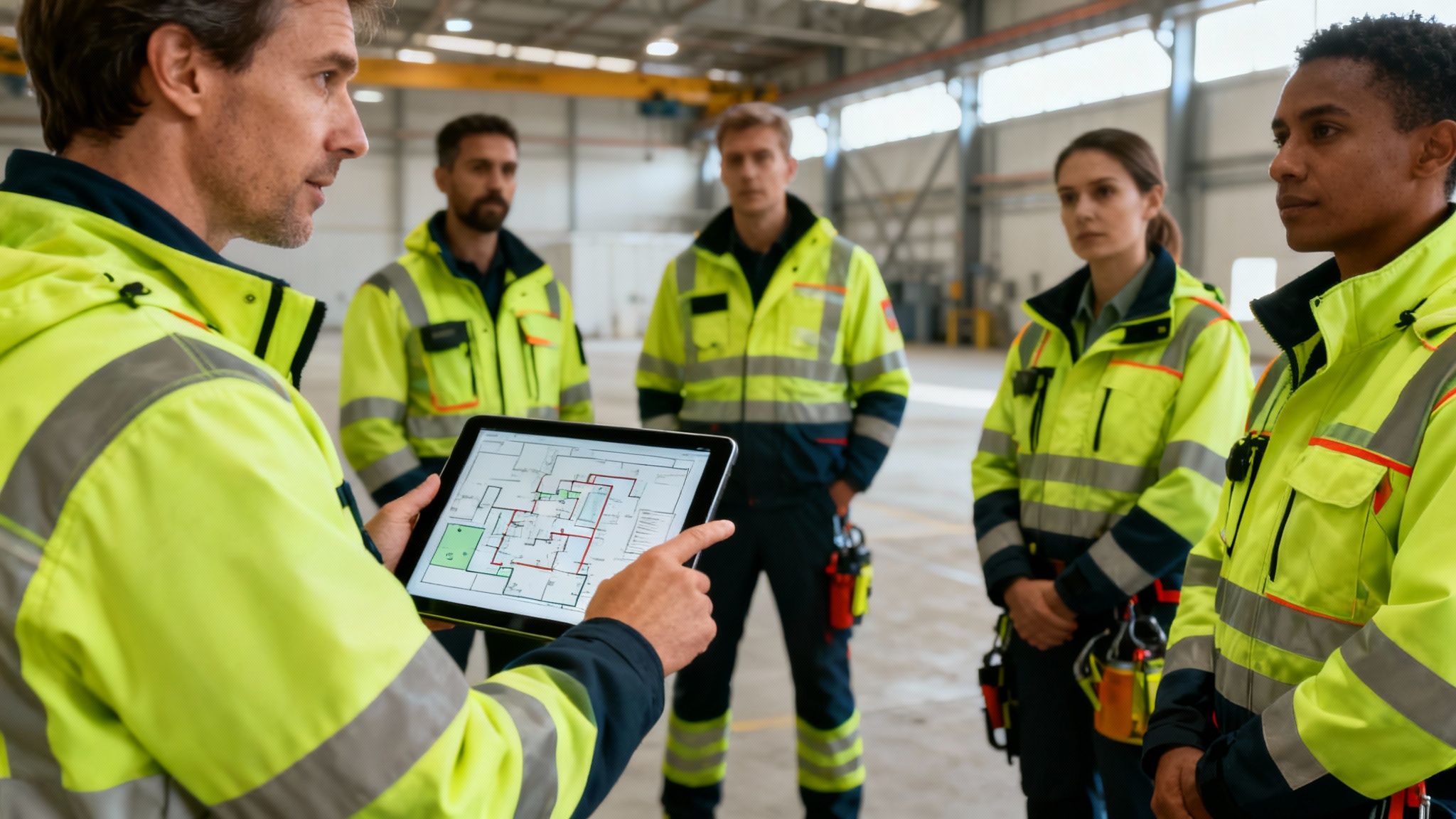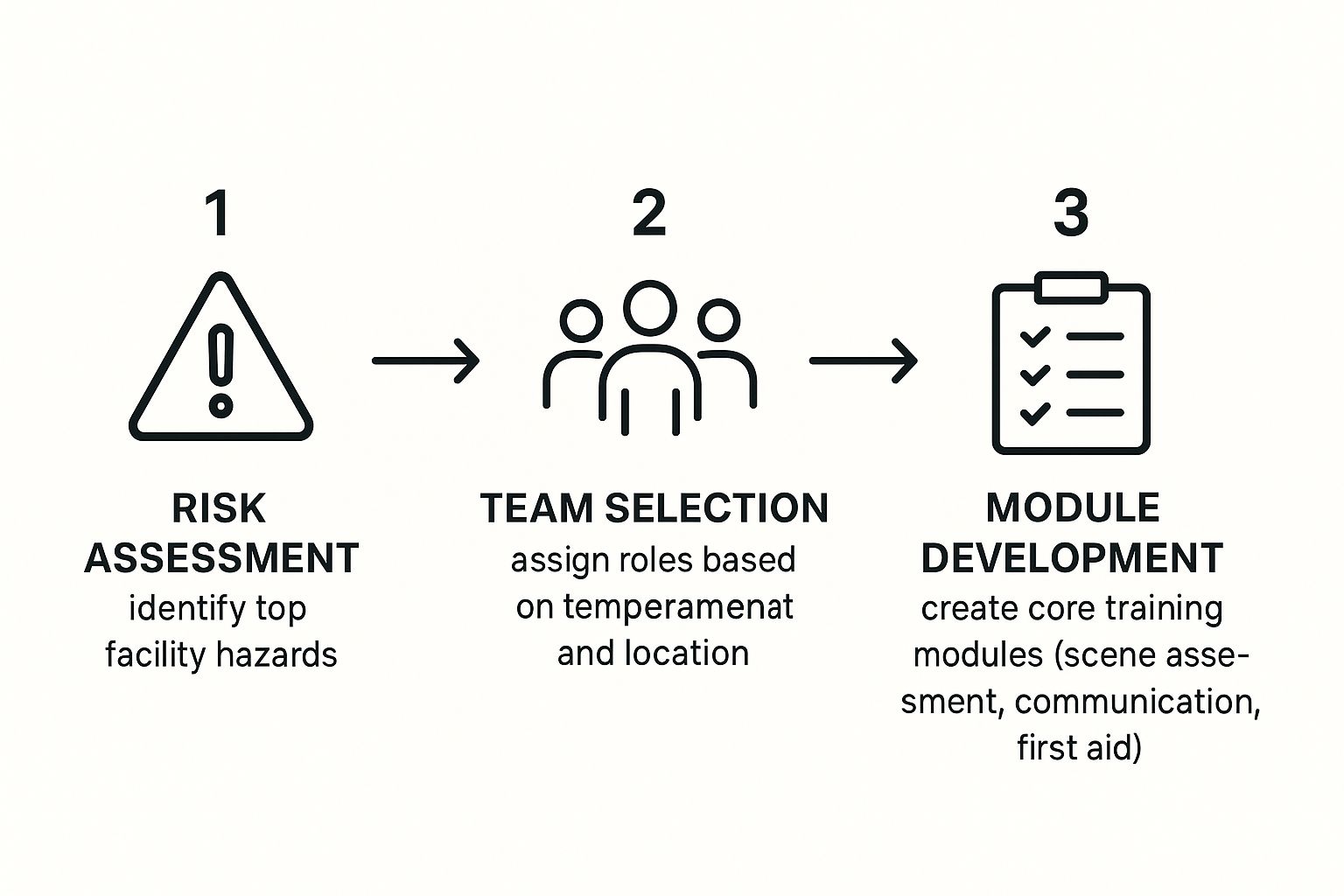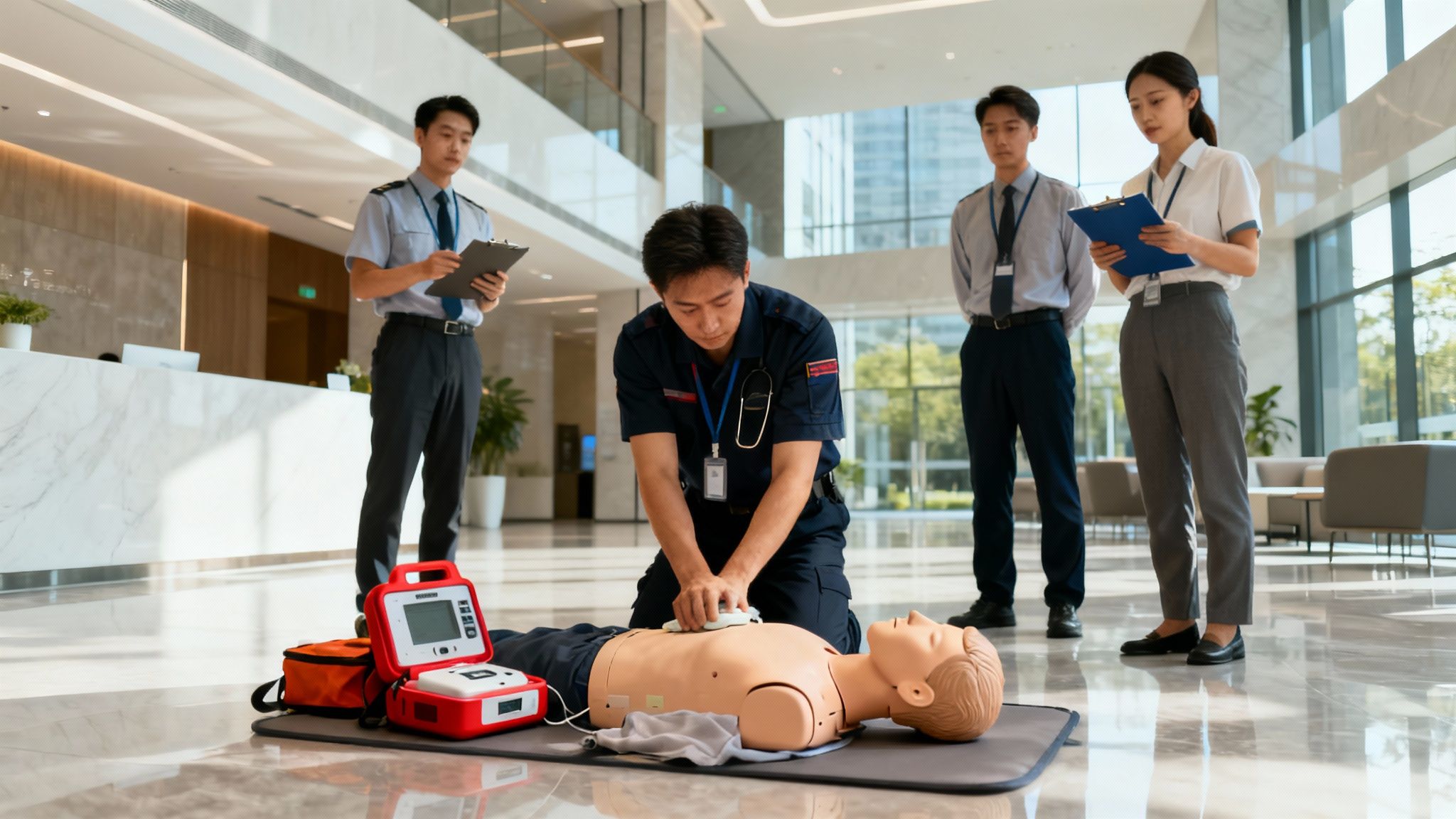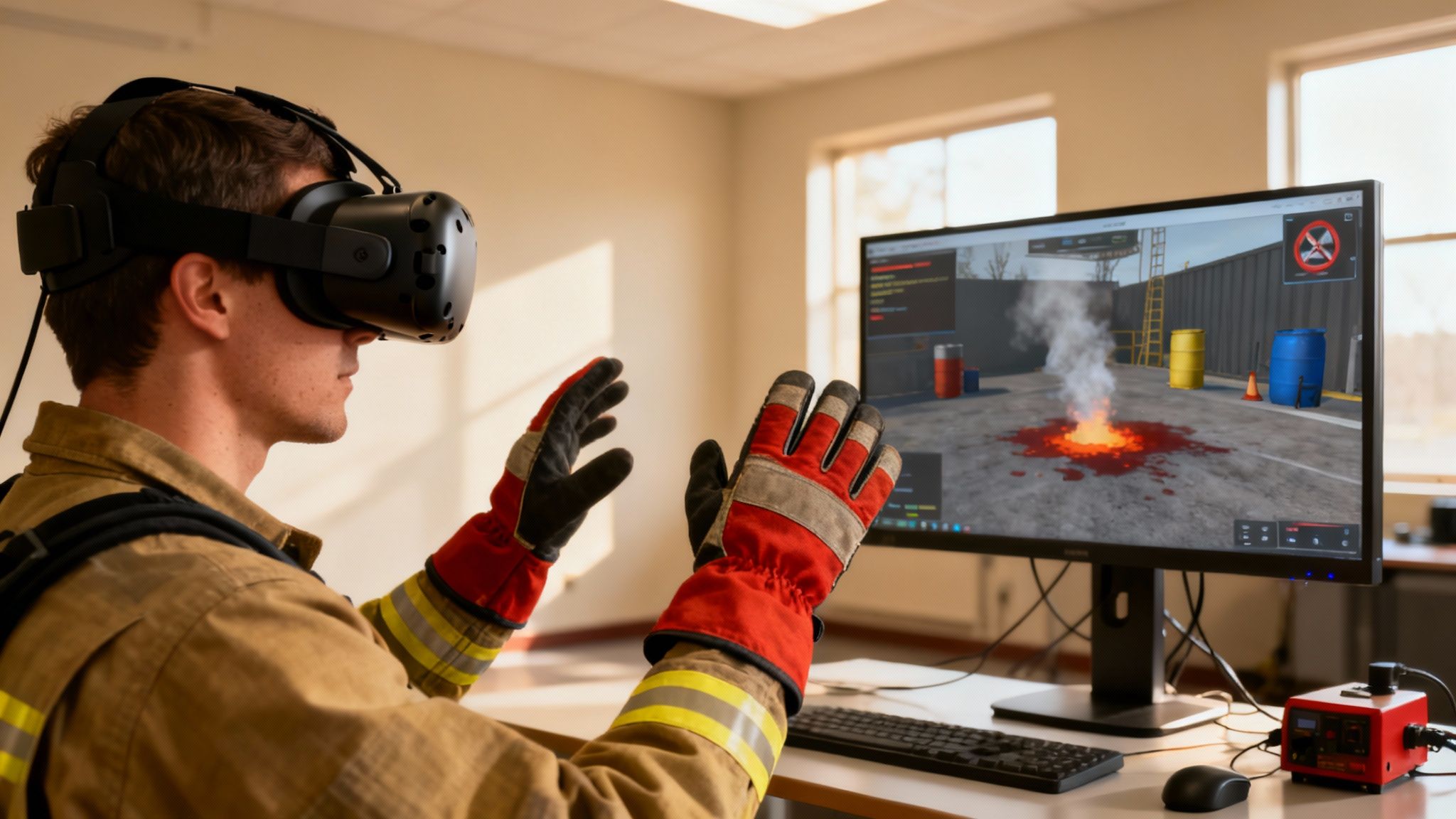Your Guide to Emergency Response Team Training
When you build an emergency response team, you're not just checking a box. You're turning a group of employees into a coordinated unit that can protect lives, property, and the future of your business when a crisis hits. It’s the process of giving that designated team the skills, knowledge, and confidence to act the right way when every second is critical.
This isn't just theory. Proper preparation is what separates a controlled incident from a full-blown catastrophe.
Why Effective ERT Training Is a Critical Investment

It’s a huge mistake to view emergency response training as just another compliance task. A well-drilled Emergency Response Team (ERT) is one of your organization's biggest assets—a proactive shield against operational, financial, and reputational ruin. The real investment isn't just in the training itself, but in stopping the staggering costs of being unprepared.
Practical Example: Picture a small chemical spill at a manufacturing plant. An undertrained team might panic, use the wrong absorbent material, and turn a minor leak into a major hazardous material incident. That leads to a facility shutdown, hefty OSHA fines, injured employees, and expensive third-party cleanup crews.
Now, imagine that same scenario with a properly trained ERT. They contain the spill in minutes using the correct spill kit, follow communication protocols, and get operations back online with minimal disruption. The cost of their training is a tiny fraction of the hundreds of thousands of dollars saved by preventing a disaster.
The True Cost of Unpreparedness
The financial fallout from a badly handled emergency goes way beyond the immediate damage. Without effective training, you’re leaving your business wide open to risks that can cripple it.
- Operational Downtime: Every hour your facility isn't running means lost revenue. A swift, competent response minimizes that downtime and directly protects your bottom line. Actionable Insight: Training your team to handle minor incidents in-house avoids costly production shutdowns. If a 30-minute response prevents a 4-hour shutdown, you've just saved 3.5 hours of revenue and payroll costs.
- Regulatory Penalties: Agencies like OSHA don't mess around. They hand out severe fines for safety violations, especially if they lead to an accident. Good training is your best defense and shows you're doing your due diligence, which can significantly reduce penalties.
- Reputational Damage: News travels fast. A poorly managed crisis can destroy public trust and send customers running. On the other hand, a capable response can actually highlight your company's commitment to safety and responsibility. You can see great examples of how coordinated responses build trust by looking at the actions of dedicated first responder teams on our Hall of Fame page.
To really get why ERT training is non-negotiable, you have to understand the essential emergency evacuation procedures for the workplace that form the backbone of any solid response plan.
An investment in training is an investment in resilience. It builds a culture where safety is instinctive, not just a policy. This proactive mindset is what allows organizations to not just survive a crisis, but to emerge stronger from it.
A Growing Market Underscores the Need
Organizations are waking up to these high stakes, and the numbers prove it.
The global emergency response training market is pegged at around $5 billion as of 2025, and it’s expected to grow by about 7% annually through 2033. This isn't just a fluke. The growth is being driven by a sharper awareness of workplace risks, stricter government regulations, and the undeniable financial upside of being prepared. This isn’t just a passing trend; it's a fundamental shift in how businesses are approaching risk.
Building Your ERT Training Framework from Scratch
Let's be honest: an effective ERT training program doesn't come from a generic, off-the-shelf binder. It’s about crafting a framework that directly tackles the real-world risks your organization actually faces. This is your blueprint for turning willing employees into a confident, capable response unit.
Practical Example: Get out from behind the desk and walk the floor. Forget generic fears and zero in on the specific, high-probability threats unique to your facility. For a downtown office, that might be a medical emergency on a high floor or a fire. In a manufacturing plant, you’re likely looking at a chemical spill or equipment failure. Talk to the people who do the work every day—they know where the real dangers are.
Once you know the what, you can define the why. That assessment should directly inform your training goals. Vague objectives like "improve safety" are useless. You need clear, measurable targets. Think: "Train ERT members to safely contain a 10-gallon liquid spill within five minutes," or "Ensure at least two ERT members per floor can perform CPR and use an AED before paramedics arrive." Goals like these give your training purpose and a clear finish line.
Identifying and Selecting the Right People
This is one of the most critical decisions you'll make. The best candidates aren't always the ones with fancy job titles. You're looking for individuals who demonstrate calmness under pressure, clear communication skills, and a genuine willingness to help.
Temperament trumps title, every time. An assembly line worker known for being level-headed is a far better choice than a supervisor who panics. You also have to think about logistics. You need coverage across all shifts and throughout your facility, not a team clustered in one department. A well-distributed team means someone is always nearby to act immediately.
Actionable Insight: Always recruit volunteers. People who choose to be on the team are far more engaged and motivated, and they'll retain their training much better than those who are forced into the role. This costs nothing but pays massive dividends in team effectiveness and reduced turnover, saving you money on constant retraining.
This infographic breaks down the foundational flow, from identifying your specific risks to developing targeted training modules.

As you can see, it all starts with a clear understanding of your specific needs. That knowledge then logically dictates who should be on the team and what they absolutely need to learn.
Designing Your Core Training Modules
Now that you've got your risks identified and your team selected, you can start building out your training curriculum. Ditch the one-size-fits-all approach. Your modules should be a direct reflection of what your risk assessment uncovered.
A solid training program needs a good foundation. The table below outlines some core modules you should consider building your program around, focusing on objectives and the real skills your team will walk away with.
Core Training Modules for Your ERT Program
| Module | Primary Objective | Key Skills Covered | Cost-Saving Tip |
|---|---|---|---|
| Scene Assessment & Safety | Teach the team to quickly and safely evaluate an incident before acting. | Hazard identification, securing the area, determining when to call for backup. | Use in-house photos of your own facility for "spot the hazard" exercises. This is free and more relevant than generic stock photos. |
| Communication Protocols | Ensure clear, concise communication during an emergency. | Internal reporting chains, using radios, briefing first responders (911). | Role-play common scenarios using walkie-talkies you already own instead of investing in complex simulation software. |
| First Aid, CPR & AED | Provide life-saving care in the critical minutes before help arrives. | Bleeding control, CPR techniques, proper AED operation and maintenance. | Partner with your local fire department or EMS for certified, low-cost training. They may offer it for free as a community service. |
| Emergency-Specific Response | Prepare the team for your highest-probability incidents. | Fire extinguisher use, spill containment, lockdown procedures, evacuation routes. | For fire safety, focus on developing a robust fire evacuation plan as a hands-on workshop, which costs nothing but time. |
These modules create a comprehensive starting point. You can—and should—add more based on your unique operational risks, like hazardous material handling or severe weather protocols. Remember, every skill taught should tie back to a threat you've already identified.
Smart Spending on Training Resources
Building a powerful framework doesn't have to break the bank. You can actually save a ton of money just by being resourceful.
Actionable Insight: Start by tapping into the high-quality materials offered by government agencies. Both OSHA and FEMA have extensive, free-to-download resources like planning guides, tabletop exercise templates, and training outlines.
Using these gives you a solid, compliant foundation for your program without the cost of developing everything from scratch. This frees up your budget for the things that really matter: hands-on training and the right equipment. That’s where your money will always have the greatest impact.
Conducting Drills That Build Real-World Skills

Let's be honest: a perfect emergency plan that just sits in a binder is completely useless. True readiness isn't built on theory; it's forged in practice. The muscle memory and calm, clear-headed decisions you need during a crisis only come from drills that simulate the pressure and chaos of the real thing.
This is where your training program transitions from just learning things to actually building skills. The goal is to make your team's response so second nature that they can execute flawlessly, even when their adrenaline is pumping.
Tabletop Exercises: The Strategic Walk-Through
Before you ever suit up for a full-scale drill, start with a tabletop exercise. This is a low-stress, discussion-based session where you gather the team around a table and talk through a simulated emergency. It's the absolute best way to pressure-test the logic of your plan.
Practical Example: Kick things off with a scenario: "A forklift just hit a chemical storage rack in the warehouse. There's an unidentified spill, and the driver is unconscious." From there, the team verbally walks through their every move.
- Who grabs the phone and calls 911 first?
- How is the area cordoned off so no one else wanders in?
- What's the protocol for notifying management, and who does it?
- Who is responsible for getting the spill containment kit?
This simple conversation will immediately expose the gaps in your plan. You might discover two people think they're in charge of communications, or that nobody actually knows where the master shut-off valve is located.
Actionable Insight: A tabletop exercise is essentially a free audit of your emergency plan. It lets you find and fix critical flaws in your strategy without the cost, risk, or complexity of a live drill. Finding a single flaw here saves thousands compared to discovering it during a real event that causes injuries or property damage.
Hands-On Drills: From Knowledge to Instinct
While tabletop exercises are for testing the logic of your plan, hands-on drills test your team's execution. These are the physical simulations where everyone actually performs the tasks required in a real emergency. This is how knowledge becomes instinct.
Your drills have to be grounded in the real-world risks you identified earlier. Don't just run a generic fire drill if your biggest threat is actually a medical emergency happening in a remote corner of your facility. Make it relevant.
Practical Drill Example: Data Center Power Outage
- Scenario: A sudden, total power outage hits your data center at 2:00 PM on a Tuesday. To make things interesting, the backup generator fails to kick on.
- Objectives: See if the team can execute manual shutdown procedures for critical servers, set up emergency lighting, and communicate status updates to leadership without the network.
- Execution: The team physically goes to the server room. They navigate with flashlights. They walk through the motions of powering down equipment in the right sequence. The communications lead has to use a cell phone or radio to provide updates to a designated manager.
Managing the Drill from Start to Finish
A great drill is more than just a good scenario. It needs solid management to make sure everyone learns and, most importantly, stays safe. Think of it as having a clear beginning, middle, and end.
First up is the briefing. Before anything kicks off, get all participants and observers together. Clearly state the scenario, what you're trying to achieve, and the safety rules. You need to drive home that this is a learning environment, not some pass/fail test.
During the drill itself, have designated evaluators observing and taking notes without getting in the way. They should be tracking key actions, how decisions are made, and how information is flowing. Using modern tools, like the coordination apps from Resgrid's personnel and equipment management suite, can be a huge help here for tracking team movements and comms in real-time.
Finally, and most critically, comes the debriefing. As soon as the drill ends, hold an "after-action review." It's vital to create a blame-free zone where everyone feels comfortable talking openly about what went well and what completely fell apart.
To get the ball rolling, focus the discussion on a few key questions:
- What was the single biggest challenge we faced?
- Did our communication plan actually work under pressure?
- Was all our emergency gear easy to find and fully functional?
- What's the one thing we absolutely have to change before our next drill?
By moving systematically from strategic tabletop exercises to practical, hands-on drills, you build a genuinely resilient team. Every simulation, big or small, uncovers ways to get better and hardens your organization's ability to respond when it really counts.
Using Technology to Make Training More Effective

Let's be honest, traditional classroom sessions and PowerPoint-heavy drills can only take your emergency response team so far. To really make training stick, you need to get creative. Thankfully, modern tech offers some powerful tools to make training more engaging, accessible, and impactful—without completely blowing your budget.
By thoughtfully weaving in the right technology, you can build skills and confidence in ways static presentations just can't match. It’s about safely simulating high-stakes scenarios and making sure everyone on the team gets the same solid, consistent knowledge base.
Immersive Training with Virtual and Augmented Reality
Virtual Reality (VR) and Augmented Reality (AR) aren't just for video games anymore; they’ve become serious tools for high-consequence training. These technologies are game-changers, letting your team practice responding to dangerous situations in a completely safe, controlled digital space.
Practical Example: Imagine a trainee facing a simulated hazardous material spill. With a VR headset, they see the chemical cloud spreading, hear the alarms blaring, and have to physically walk through the steps of choosing the right PPE and deploying a spill kit. This builds muscle memory and hones decision-making skills under perceived stress—something a slide deck could never do.
Actionable Insight: The real savings with VR come from reusability and safety. You can run that chemical spill module dozens of times with a single software investment. This eliminates the cost of consumable materials (like spill kits), extensive cleanup, and the operational downtime required for a full-scale physical drill. You get superior practice at a fraction of the long-term cost.
Simulation-based training, especially VR, is a huge leap forward for emergency response. This market is projected to hit around $1.08 billion by 2033, which tells you just how seriously organizations are investing in it to improve skill retention and decision-making under pressure. You can dive deeper into the market growth and its impact on emergency training industry insights.
Accessible and Affordable Tech Solutions
Not every tech upgrade needs to break the bank. There are plenty of highly effective tools that are affordable and surprisingly easy to roll out, making them perfect for organizations of any size looking to elevate their emergency response team training.
These platforms are all about managing that foundational knowledge and ensuring everyone has what they need, right when they need it.
- Online Learning Management Systems (LMS): An LMS is perfect for delivering standardized training on core topics. Think of it for your emergency action plan, communication protocols, or hazard identification guides. It ensures every team member gets the exact same baseline info, and you can easily track completion to stay compliant.
- Mobile Apps for Instant Access: In a real emergency, nobody has time to search for a three-ring binder. Equipping your ERT with mobile apps that hold emergency checklists, contact lists, and site maps puts critical information right in their hands. It's simple, but incredibly effective.
Leveraging Management Platforms for Smarter Training
Beyond individual tools, a comprehensive management platform can tie your entire training and response ecosystem together. These systems are built to handle everything from scheduling drills to communicating in real-time during an actual crisis.
Practical Example: Using a platform with robust features for personnel and equipment management lets you see exactly which team members are on-site, what certifications they hold, and where critical equipment is stored. This data isn't just gold during a crisis; it's invaluable for planning smarter training drills.
You can spot gaps in shift coverage or see which team members are due for recertification, allowing you to make your training efforts more targeted and efficient. It transforms routine management into a powerful tool for continuous improvement.
Measuring Performance and Driving Improvement
So, you've run the training drills. That's a great start, but it's not the finish line. A truly effective emergency response program isn't a "one and done" deal—it's a living, breathing system that needs to be constantly poked, prodded, and improved. Just going through the motions isn't enough.
We've seen a lot of organizations miss a massive opportunity right here. They treat training like a checkbox item, but the real magic happens in the cycle of practice, measurement, and refinement. Skip that cycle, and skills start to fade, plans get dusty, and the investment you made in training just slowly leaks away.
Looking Beyond Simple Pass and Fail Metrics
To really get a grip on your team's readiness, you need to dig deeper than a simple "pass/fail" on a drill. Tracking the right Key Performance Indicators (KPIs) gives you a crystal-clear picture of how your team actually performs under pressure. It shows you exactly where the weak spots are so you can focus your efforts.
Here are a few KPIs that we’ve found to be incredibly revealing:
- Decision-Making Speed: Clock the time it takes for the incident commander to make that first critical call—say, ordering an evacuation versus a shelter-in-place. This isn't about rushing them; it’s about measuring their confidence and the clarity of your plan.
- Communication Clarity: Count the number of repeated or garbled messages that go out over the radio. If that number is high, you know you need to hammer down on communication protocols.
- Skill Retention Rate: Let’s say you ran a first aid course. Six months later, pop-quiz team members on applying a tourniquet. If the pass rate is low, it’s a red flag that you need more frequent refreshers.
- Time to Task Completion: Put a stopwatch on specific objectives, like how long it takes the team to find and shut off a simulated gas leak. This gives you a hard number to beat in the next drill.
Actionable Insight: Consistent internal reviews are infinitely cheaper than waiting for a real crisis to show you where your plan fails. A single botched response can trigger a cascade of costs from downtime, fines, and lawsuits. Identifying one communication flaw in a drill that costs $500 to run could prevent a $50,000 incident.
The Power of the After-Action Report
After any drill—or a real-world event—your most powerful tool is the After-Action Report (AAR). This isn't just a memo summarizing what happened. It’s a structured deep-dive designed to pull out lessons learned and turn them into a concrete plan for getting better.
For an AAR to work, the debrief has to be a 100% blame-free zone. The goal is to fix the process, not point fingers. You get honest, open feedback by focusing the conversation on what happened, not who messed up.
A simple but killer AAR template should hit these four points:
- What was our plan? (A quick rundown of the drill’s objectives.)
- What actually happened? (The real-world sequence of events.)
- Why did it happen? (Dig into the root causes of what went right and what went wrong.)
- What are we going to do about it? (Create a to-do list with names and deadlines.)
Practical Example: During a debrief, a team member admits they grabbed the wrong fire extinguisher for a simulated electrical fire. Instead of getting chewed out, the AAR captures an action item: "Relocate all Class C extinguishers to more visible spots and update facility maps. Owner: Facilities Manager. Due: Next Friday." Just like that, a small failure gets turned into a permanent safety upgrade that costs almost nothing.
Combatting Skill Fade with a Regular Schedule
Emergency response skills are perishable. The team member who was a CPR pro a year ago might forget crucial steps today if they haven't practiced. We call this skill fade, and it's one of the biggest silent threats to a team's readiness.
The only way to fight it is with a consistent, year-round training calendar. Forget cramming everything into one marathon training day. Shorter, more frequent sessions are proven to be miles more effective for keeping skills sharp.
Actionable Insight: A smart schedule saves a ton of money by avoiding the need for complete re-training from scratch. A one-hour refresher drill costs far less in terms of payroll and lost productivity than sending the whole crew back to a two-day course because their certifications lapsed. Keep a steady drumbeat of training, and you'll keep your team sharp and your budget in check.
Common Questions About ERT Training
When you're setting up an emergency response team training program, a lot of practical questions are bound to come up. From figuring out the budget to setting a realistic schedule, getting these details right is what separates a program that looks good on paper from one that actually works.
Let's dive into some of the most common questions we hear from folks on the ground.
How Much Should We Budget for ERT Training?
This is always the first question, and the honest answer is: it really depends. For a small office, you might only be looking at a few thousand dollars for some basic first aid certifications and supplies to run internal drills. But for an industrial plant with complex hazards, that number can easily jump into the tens of thousands for specialized equipment and expert outside trainers.
The goal isn't just to spend money; it's to spend it wisely.
Actionable Insight: Start with the high-quality, free planning resources from government agencies like OSHA and FEMA. Use their templates and guides to build your core framework. This can save you thousands in consultant fees and frees up your budget for the things that deliver the most impact—hands-on practice and proper personal protective equipment.
Another practical move is to look internally. You probably have knowledgeable people on staff who can lead foundational training sessions. Tabletop exercises, for instance, are an incredibly cost-effective way to poke holes in your plan's logic before you pour money into a full-scale, resource-heavy drill. Think of training as an investment that prevents much bigger losses from fines, operational downtime, and tragic accidents down the road.
What Is a Realistic ERT Training Schedule?
Solid training isn't a one-and-done event; it's a continuous cycle. Sure, formal certifications like CPR and First Aid might only need a refresh every couple of years, but your team's practical skills need far more frequent attention to fight off "skill fade."
We've found that a layered approach to scheduling works best:
- Quarterly Tabletop Exercises: These are short, discussion-based sessions. Practical Example: A 1-hour session simulating a bomb threat to test your communication and evacuation chain of command.
- Semi-Annual Skill Drills: At least twice a year, get hands-on. Practical Example: A 30-minute drill where teams practice using a spill kit on a simulated water-based spill.
- Annual Full-Scale Drill: Try to run one big, realistic simulation a year. Practical Example: A half-day drill involving a fire scenario, complete with smoke machines (safely used) and coordination with the local fire department.
Keep in mind, research consistently shows that shorter, more frequent training sessions are way better for long-term retention than one grueling, all-day event once a year.
What Are the Biggest Mistakes to Avoid in Training?
The single most common—and costly—mistake we see is creating a beautiful plan that lives only in a binder. If your team has never physically walked through the steps, I can almost guarantee it will fall apart under the stress of a real crisis. Practice is simply non-negotiable.
Another huge error is grabbing a generic, one-size-fits-all training program. A plan designed for a chemical plant is massive overkill for a corporate office, but it's dangerously inadequate for the plant it was actually designed for if not customized. Your training has to match your specific risks.
Finally, a lot of organizations skip the post-drill debriefing. This is a massive missed opportunity. The debrief is where the real learning happens. You have to create a blame-free space where the team can be brutally honest about what worked and what needs to be fixed immediately. That feedback is pure gold.
How Can We Keep Team Members Motivated?
Engagement comes from two things: realism and purpose. Ditch the boring slideshows. Get your team involved in interactive, hands-on scenarios that force them to solve problems.
Practical Example: You also need to vary the drills to keep them from getting stale. If you run the exact same fire drill every time, people will just go through the motions. Throw in some curveballs—a blocked exit, a simulated injury (use a volunteer with some fake blood), a communication failure—to make them think on their feet.
Most importantly, keep reminding them why they're doing this. Their training directly protects their colleagues and the business. Publicly recognize their commitment and build a strong team identity. When people feel like their role is genuinely critical, they stay sharp and motivated.
At Resgrid, LLC, we build the tools that keep your team connected, coordinated, and ready for whatever comes next. Our platform helps you manage everything from personnel and schedules to real-time communication during a crisis, ensuring your hard-earned training translates into effective action. Find out how we can support your emergency response program by visiting https://resgrid.com.

